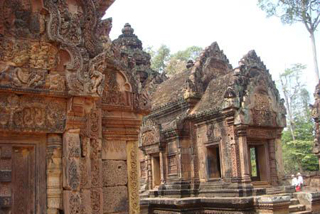Kunming of Yunan Tour Package
Golden Temple
Located on top of Mingfeng (Singing
Phoenix) Hill is the home of the Taoist Taihe Palace (Hall of
Supreme Harmony), which is the largest copper temple in China. It is
also known as the Tongwa Temple (Bronze Tile Temple) and by its
popular name, the Golden Temple.
The history of the Golden Temple starts during the Ming
Dynasty and the reign of the Emperor Wanli in 1602. At that time the
governor of Yunnan Province was a devout Taoist who built this
temple to honor the Taoist hero-god Zishi. According to legend,
Zishi had a golden palace in the northernmost extremity of the
universe. But the Golden Temple didn't stay in its original place
for very long. Just 35 years later, in 1637, the entire original
temple was moved to Jizu (Chicken Foot) Mountain in western Yunnan.
Three decades later in 1671 during the Qing Dynasty, Wu Sangui, the
governor of Yunnan Province, built an exact duplicate of the
original temple. This temple was undisturbed for almost two hundred
years until the Muslim rebellion of 1857, during which the Golden
Temple suffered some damages. Emperor Guangxu ordered its complete
repair and in 1890, using 250 tons (246 gross ton) of solid bronze,
the entire temple was again rebuilt. Except for the staircases and
balustrades, which are made of marble, the walls, columns, rafters,
roof tiles, altars, Buddha statues, wall decorations and the banner
near the gate tower are all made of copper. The burnished copper
gleamed like gold and that is why people named it the Golden Temple.
Since its last renovation, this beloved copper temple on the top of
Mingfeng Hill has been well cared and has become the most famous
Taoist shrine in Yunnan Province.
As with most Taoist temples, you approach it by
climbing up a mountainside on winding stone steps and pass through a
series of "Heavenly Gates". The three Heavenly Gates of the Golden
Temple are highly decorated with painted archivolts and carved beams
and rafters.
The beautiful walk up the stairs to the temple helps
you to leave your mundane cares behind you. You may well find that
the closer you get to the Golden Temple, the more peaceful and
lighthearted you feel as the extreme beauty of Mingfeng can create a
sense of inner harmony to its visitors.
At the end of the path, there is a miniature, medieval
city wall standing on a platform. There you will also find the
Lingxing Gate through which you could enter the Golden Temple. Among
the interesting artifacts and artistry of the Golden Temple is a
double-edged sword with the Big Dipper engraved on it. Legend has it
that this sword, which weighs more than 20 kilograms (44 pounds), is
the magic sword of Zhen Wu, a Taoist deity, who guards Mingfeng
Hill. Near the temple is a 600-year-old camellia tree that signals
the approach of spring every February by giving hundreds of
exquisite blossoms.
Behind the Golden Temple, there is a three-story-high
Bell Tower that was built in 1984 to house a large, 580-year-old
copper bell which is three point five meters (16.4 feet) high and
weighs an incredible 14 tons (13.7 gross tons).
The hillside around the Golden Temple abounds with pine
trees, evergreens, hardy cypresses, and a multitude of plants. As
far back as the Qing Dynasty, the natural beauty of Mingfeng Hill
has caused it to be acclaimed as the Fairyland of Mingfeng. The
Golden Temple is only 11 kilometers (7 miles) from
Kunming and is easily accessible by
public transportations.
|

